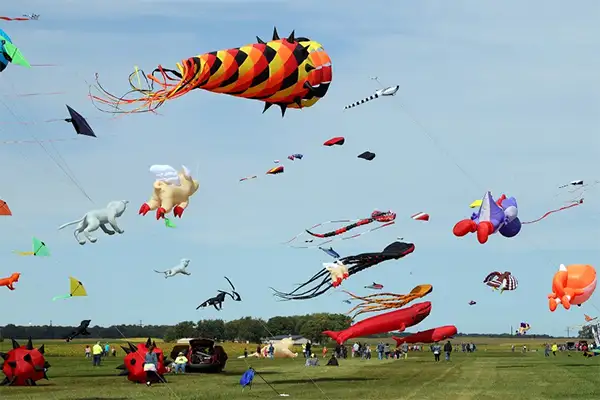
The Sky’s the Limit
Welcome to the fantastical world of International Kite Day, an annual celebration that transforms the sky into a vibrant tapestry of colors and shapes. Once a year, people across the globe look upwards, not for weather predictions or stargazing, but to revel in the ancient and joyful art of kite flying. This isn't just a pastime; it's a global phenomenon where the sky becomes a playground for kites of every imaginable design. From handcrafted traditional kites to high-tech aerodynamic wonders, this day has it all.
On International Kite Day, the air is filled not just with kites, but with laughter, cheers, and an infectious sense of fun. It's a day when adults can rediscover the childlike wonder of watching a kite climb higher and higher, and children can marvel at the simple magic of a paper and bamboo creation dancing in the wind. This day is marked by a spirit of freedom and creativity, where the only limits are the lengths of string and the expanse of the sky.
Imagine a scene where every gust of wind is a new opportunity for adventure. Parks, beaches, and open fields become arenas of excitement, with people from all walks of life coming together to participate in this aerial ballet. The air buzzes with the excitement of first-time flyers and the seasoned expertise of kite enthusiasts, creating an atmosphere that's as electric as it is serene.
Kite flying on this day is more than a hobby; it's a celebration of culture, history, and the sheer joy of seeing a simple creation soar high above. It's a reminder of the beauty of the outdoors and the playful side of nature that we often forget in our busy lives. International Kite Day is not just about flying kites; it's about lifting spirits, sharing laughs, and creating memories that, much like kites on a windy day, soar high and stay with us long after the kites are packed away.
A Brief (and Breezy) History
The story of kites is as colorful and varied as the kites themselves, tracing back over two millennia. International Kite Day doesn't just celebrate the present-day joy of kite flying; it honors a rich history that spans cultures, continents, and centuries. Kites are not merely children's playthings but have been significant in scientific discovery, cultural expression, and even historical events.
Kites originated in ancient China, where they were crafted from bamboo and silk and used not only for recreation but for practical purposes. They served as tools for signaling, measuring distances, testing the wind, and even for fishing. The Chinese philosophy of using kites to harmonize with nature rather than struggling against it laid the foundation for the global kite culture we know today.
The art of kite making and flying spread from China to Korea, Japan, and across Asia, where each culture infused it with its own unique flavors. In Japan, kites became larger and more elaborate, often used in religious ceremonies and public festivals. In India, kite flying evolved into a competitive sport, where the skies become battlegrounds during festivals, with participants engaging in 'kite fights' using kites with glass-coated strings.

But the history of kites is not just about recreation and culture. In the 18th century, kites played a crucial role in scientific advancement. The most famous instance is Benjamin Franklin's kite experiment in 1752, which demonstrated the electrical nature of lightning. This experiment marked a significant milestone in the study of electricity and laid the groundwork for future innovations.
Kites have also played a part in aviation history. Before the Wright brothers' first powered flight, pioneers in flight like Lawrence Hargrave used kites to experiment with aerodynamic structures and lift, paving the way for modern aircraft design.
Today, International Kite Day celebrates this rich and diverse history. It's a day that brings people together, not just to fly kites, but to connect with a tradition that transcends time and geography. The festival serves as a reminder of our shared human ingenuity and the simple pleasures that have united cultures throughout history.
The Art of Kite Making
Kite-making is where creativity takes flight – quite literally. It’s an art form that involves more than just sticking paper and sticks together. You need an artist's eye, a craftsman's hands, and sometimes, the patience of a saint. Workshops and competitions held on this day showcase the incredible talent and ingenuity that goes into creating these aerial beauties. From traditional diamond kites to 3D kites that look like they could be part of a sci-fi movie, the variety is as endless as the sky itself.
The real magic begins when these kites take to the skies. Kite flying is like a dance - a tug here, a pull there, and suddenly, you're waltzing with the wind. It's a skill that can make you feel like a conductor orchestrating a symphony in the air. But let's be real – it's also a comedy of errors with tangled strings, sudden nose-dives, and the occasional "kite-eating tree" incidents. It's all part of the charm!
International Kite Day is celebrated with zest around the world. In some places, it's a festival that turns the sky into a canvas painted with kites. There are kite battles where the goal is to cut the opponent's string, and then there are those who prefer to coexist peacefully, floating side by side. The sky buzzes with a kaleidoscope of colors, designs, and shapes, each telling its own story.
This day is not just about flying kites; it's about flying connections. It brings people together, bridging gaps and creating friendships. Parks and beaches become social hubs, filled with laughter, cheers, and the collective groans of a kite crash. It's a community event where everyone, from the young at heart to the actual young, can share in the joy.
As International Kite Day winds down, it leaves us with a sense of nostalgia and joy. It's a reminder of the simple pleasures in life and the beauty of looking up once in a while. So next time you see a kite soaring high, remember that it's more than just a piece of paper on a string; it's a story, an art, and a little bit of magic, dancing with the wind.
Please Share our Content

















 "Sláinte!" is a traditional Irish expression used as a toast, equivalent to "Cheers!" in English.
"Sláinte!" is a traditional Irish expression used as a toast, equivalent to "Cheers!" in English.